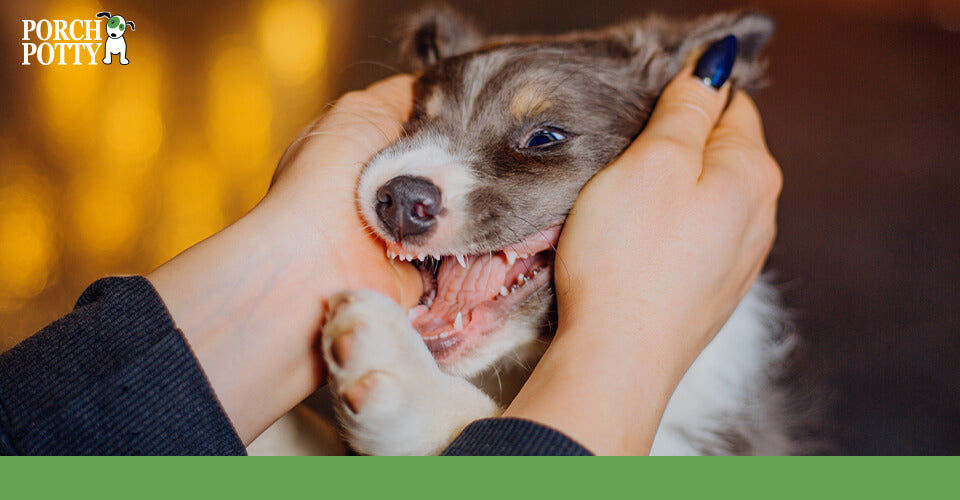
Puppies are sweet, adorable, and armed with needle-sharp teeth. We've got a few tips and tricks to make sure Fido's chompers stay away from you and your stuff.
Welcoming a new puppy into your home is an exciting and joyful experience, but it also comes with its fair share of challenges. As adorable as they are, puppies often exhibit behaviors that can be frustrating and overwhelming for new owners. From biting to barking, these common issues can disrupt your household and test your patience. However, with the right approach and consistent training, these behaviors can be managed effectively. In this article, we’ll explore the top five puppy behaviors that people search to remedy, offering practical tips to help you raise a well-behaved and happy furry friend.
Biting
Puppy biting is a natural behavior, as young dogs use their mouths to explore the world and relieve teething discomfort. However, without proper guidance, this innocent nibbling can turn into a problematic habit as they grow older. To curb biting, it’s essential to teach your puppy bite inhibition, which is the ability to control the force of their bite. When your puppy bites too hard during play, let out a high-pitched yelp to mimic how another dog would react, and immediately stop playing. This helps them understand that biting too hard ends the fun. Additionally, always provide plenty of chew toys to redirect their biting energy to appropriate objects. Consistency and patience are key, as it may take time for your puppy to fully grasp the concept.
Begging/Whining
Begging and whining are behaviors that can quickly become ingrained if your puppy learns that this behavior results in attention or treats. Whether it’s at the dinner table or when they want to be let out, persistent whining can be both annoying and challenging to manage. The key to discouraging this behavior is to avoid rewarding it. When your puppy whines or begs, resist the urge to give in or comfort them, as this only reinforces the behavior. Instead, teach your puppy commands like “quiet” or “place,” directing them to a specific spot during mealtimes or when guests arrive. Consistently ignoring begging and only rewarding calm, quiet behavior will help your puppy learn that whining isn’t the way to get what they want.

Barking is how dogs communicate, but puppies are still learning when it's appropriate to bark.
Excessive Barking
While barking is a natural form of communication for dogs, excessive barking can quickly become a nuisance, especially if it’s triggered by every little noise or passerby. Puppies may bark excessively due to excitement, fear, or simply to get attention. To manage this behavior, it’s important to first identify the triggers and then work on desensitizing your puppy to them. Teaching commands like “quiet” can be effective, rewarding your puppy when they stop barking on cue. Additionally, ensuring your puppy gets enough physical exercise and mental stimulation can reduce their need to bark out of boredom or excess energy. Remember, consistency is crucial, so avoid inadvertently encouraging barking by responding every time your puppy makes noise.
Leash Pulling
Leash pulling is a common issue for puppies, as they’re naturally curious and eager to explore the world around them. However, allowing your puppy to pull on the leash can make walks stressful and even dangerous, especially as they grow larger and stronger. To teach your puppy proper leash manners, start by using a no-pull harness that discourages pulling. When your puppy begins to pull, immediately stop walking and stand still until they return to your side. Once they’re calm and walking beside you, reward them with praise or a treat, then continue your walk. This technique, often called “stop-and-go,” teaches your puppy that pulling gets them nowhere, while walking calmly leads to progress and rewards. With patience and consistency, your puppy will learn to walk politely on the leash, making your outings together much more enjoyable.

Just like babies, puppies need to develop bladder control before they can fully be potty trained, but consistency in potty times can help.
Peeing in the House
One of the most frustrating challenges for new puppy owners is dealing with indoor accidents. Puppies have small bladders and limited control, which means consistent potty training is essential. To prevent accidents, establish a regular potty schedule, taking your puppy outside first thing in the morning, after meals, and before bed. Praise and reward your puppy immediately when they go in the right spot to reinforce the behavior. For those living in apartments or homes with limited outdoor space, Porch Potty offers an excellent solution. This indoor/outdoor dog potty provides a convenient spot for your puppy to relieve themselves when getting outside isn’t an option. By using Porch Potty, you can help your puppy develop good potty habits, making the transition to full house training much smoother.
Final Thoughts
Raising a well-behaved puppy takes time, patience, and consistency, but addressing these common behavioral issues early on can make a world of difference. From curbing biting and excessive barking to ensuring your puppy is properly potty trained, the right strategies can help you create a peaceful and happy home for both you and your furry friend. Remember, tools like Porch Potty can be invaluable in supporting your puppy’s training journey, especially when it comes to preventing indoor accidents.
If you’re ready to take control of your puppy’s behavior and set them up for success, explore more tips and resources on our website. And don’t forget to check out Porch Potty, the perfect solution for convenient and effective potty training. With the right approach, you’ll be well on your way to raising a well-mannered and loving companion.
For more information on training your puppy, check out these articles:
Command and Control: Essential Training Commands for Every Dog
Mind Games: Engaging Mental Stimulation Activities for Your Dog
Decoding and Solving 5 Common Dog Behaviors: From Chewing to Jumping



